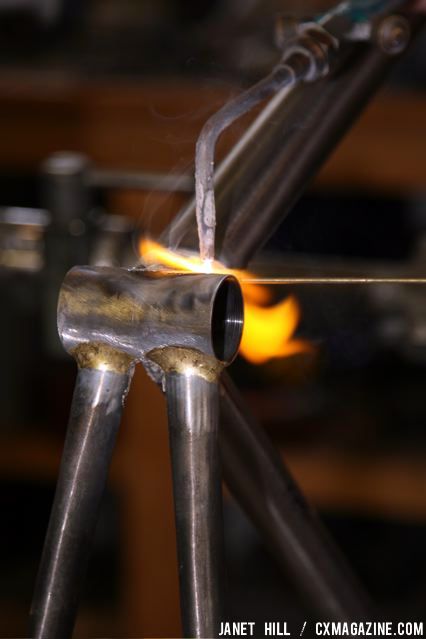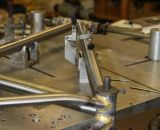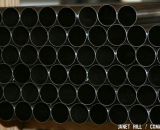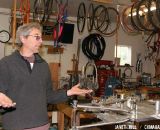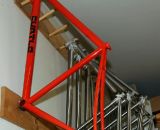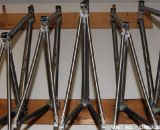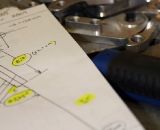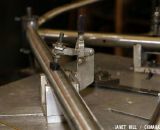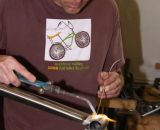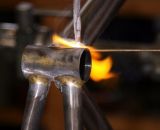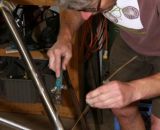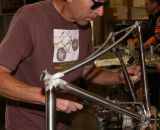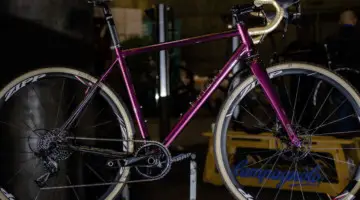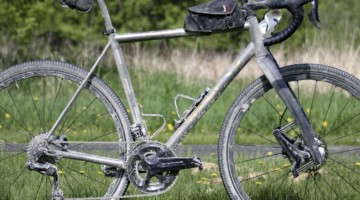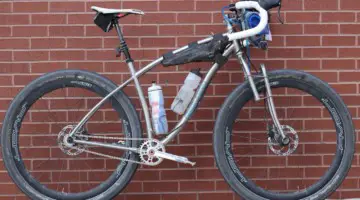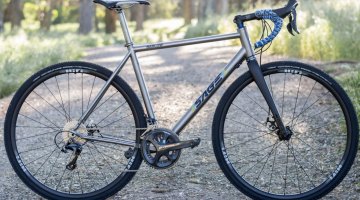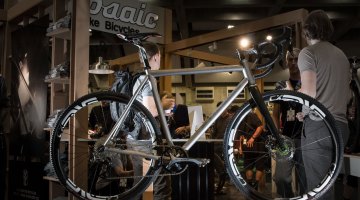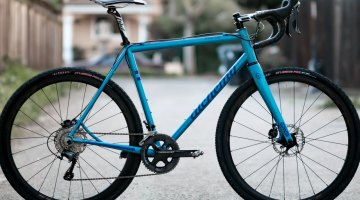by Dave Queen
It is never too early to start planning for next season.
Cyclocross is all about passion. A custom frame is often where a passionate cyclist and a passionate frame builder cross paths. For some cyclists, a bike is a tool; for others, it is a trusty companion with a name and a soul. The romantics among us look at the intersection of metal tubes and see art. Those who measure grams, watts and heart rate view everything in terms of performance. If you had a bike made just for you, what would it be like?
Cyclocross Magazine sat down for a candid conversation with veteran frame builder Doug Curtiss of Curtlo Cycles. Doug shares his insights gained from years both at the center of the sport and countless hours with his head down designing and making bikes.
A one-man operation situated in a recreationalist’s nirvana, Doug builds bikes for a spectrum of riders from middle-aged road racers to NBA-sized mountain bikers. Tall and short, rich and struggling, local and international riders of all skill levels turn to Curtlo for custom bikes. After building frames for some of the biggest names in North American cycling in the 1990’s, Doug Curtiss plies his trade for the racers of today as well as more pedestrian riders, but his passion and love for the sport is evident both in conversation and in the bikes that bear his name.
Doug Curtiss is a tall, cagey rider. His hair has more gray than it used to, but his eyes sparkle when he talks of the sport he loves. Doug speaks with a quiet reverence for cycling and the art of frame building. Only after probing did he ultimately reveal some of the experiences that make you realize that this is a frame builder who speaks with a very subtle, but well-earned, authority.
Cyclocross Magazine: What do you love about what you do?
Doug Curtiss: The end result. When I build a bike for someone who is either too tall or too short or has some other special need and they can’t find anything out there. When they ride the bike I built for them, their whole world of cycling opens up. They are no longer going over the bars, or too stretched out because their bike was too short or too long. It is when they say, “this bike made a difference for me.” When they tell me, ‘yeah, this is right, this works for me. I’ve never been on something that fit me until now.’ The tall guys or the real short riders who have never been on something that truly fit them, when they get to ride something that fits, that is when bike building is really satisfying.
CXM: What have some extreme builds been?
DC: The tallest guy was also the heaviest. He was seven feet, four inches tall and three hundred forty pounds at the time. He couldn’t find anything even close.
CXM: What did you have to do special for him?
DC: Geometry and materials. The geometry had to fit him and also avoid extremes so he could use off the shelf components. Except for the 215mm crank arm length, most of the parts were normal. I made an especially long steerer tube for his Marzocchi suspension fork and the fork techs came up with a special spring rate. The wheels used 48 spokes. The bike truly fit him and could handle his size and weight. On the other hand, I built a road frame for an endomorph that was a challenging design. It is the smaller frames that have more design issues than the larger frames.
CXM: What are the benefits of a custom frame?
DC: Well, it is built for you. Not only does it fit size-wise, but you can fine tune to the riders weight and riding style. The idea is to be balanced on your bike so that you are riding as fast as possible with the least amount of energy output.
CXM: What are some drawbacks of a stock frame?
DC: The biggest question is fit, then comes riding style and tuning a frame for an individual’s weight. You have to ask yourself, “was this bike designed for me or is it made for the guy who is fifty pounds heavier, or fifty pounds lighter than me?” When I build a bike for someone who had an existing bike where the fit was close, a custom bike gives them an increase in performance. Two guys can be the same height and one weighs 130 pounds and the other weighs 190 pounds. The off the shelf frame can be too stiff for the 130 pounder and too noodley for the 180 pound guy. A custom bike is tuned to be perfect for the rider it is designed for.
CXM: What special considerations do you have when building a cross bike?
DC: The first goal is always fit. From my perspective that all relates to riding position. That applies whether I am building a road bike, a mountain bike, or a cyclocross bike. Of course, for a cyclocross bike, you will have different geometry and more clearance for tires and mud. You will tend to have a higher bottom bracket, and depending on the rider you might be beefing up the frame to account for rough terrain or front-end impact. On a road bike, you just don’t have those same considerations. On a cyclocross bike you have handling issues, obstacles to overcome, varied surfaces so you can tune the riding characteristics to a riders’ personal preference.
CXM: Who is your typical customer? Middle aged guys who want to go faster with money and time?
DC: Kind of all over the place, there are the guys who scrape together the money, others who buy a new frame every few years. Because of the Internet, people read reviews and then they want a custom bike. It doesn’t seem like there is any specific demographic. It used to be the racing crowd, but now it is all over the place. I build bikes for the full spectrum.
CXM: How do you feel about what you are doing?
DC: It is pretty much living the dream …
CXM: What are the downsides of living the dream?
DC: Having to do so many different things. Having to pay bills, keep current on emails and phone calls, scheduling. All the aspects of running an ongoing business can be really stressful. There are just so many things. Although I enjoy all of the different aspects, I would rather just concentrate on building bikes, because ultimately, getting the frame to the customer gives the greater satisfaction to the entire process.
CXM: What got you started?
DC: I couldn’t find a bike that fit. My riding partner was big guy who was not only tall but was also a power lifter who destroyed everything he rode. We started making frames for selfish reasons and then for friends and then, frankly, when I got laid off from my Aerospace job I thought about taking it full time. The mountain biking boom was just starting and the timing, luckily for me, was perfect. That was over twenty years ago that I decided to try and make a living at frame building.
CXM: What has twenty years of frame building experience given you? There are some new guys who seem to be making bikes with just a few years of experience … What would tell someone who is starting out? What did it take?
DC: It didn’t happen overnight. It was a lot of work. I would say perseverance was key. And for someone starting out; now is a good time. The handmade bike show is a great showcase. Actually when I first started making frames it was 32 years ago, then 20 years ago I went full-time and then it took five years just to establish a name.
I was in California at the time and that was where the scene was. Mountain Bike Action, Mountain Biking Magazine and Bicycling magazine were all based there, and all of the area’s events … Mountain bike races in Big Bear, Mammoth Mountain and all over California. There were all of the California based teams like Yeti and Kahlua. There were road races every weekend. It was a great place to try and establish myself in the industry. I just squeezed myself into the scene.
I supported Team Kahlua with frames when we were both based in California. On the US team, they had Julie Furtado, Inga Thompson, Julie Young, Patricia Walters, and Carolyn Donnelly. These were the big names of women’s cycling at the time. On the Canadian team, there was Alison Sydor, Tanya Dubnikov and Leslie Thomlinson. It was so cool to see photos of my bikes in magazines like Sports Illustrated and receiving all of the pre-Olympic and Olympic coverage. That was pretty exciting to be part of that.
CXM: How much of bike building is math and science, as compared to art and craftsmanship? How do you view yourself?
DC: I view myself as a very practical artist. My dad was a finish carpenter and was very artistic, I have two sisters who are artistic. I feel like I have this stuff flowing through me. I didn’t choose to do it with wood, or fine art, I do it with frames. I don’t look to make things artsy first. I look at making something as efficiently and effectively as I can with the material first, but I like to do it in a way that is both artsy and functional. I think an ovalized down tube is very artsy, but it also serves a purpose to increase bottom bracket stiffness. Or a curved seat stay that adds compliance. They have a design function, and they look really cool. They actually serve a purpose. Now, I’m not going to put yet another bend in a seat stay to make them look even artsier. It needs to be functional first, and artsy second.
CXM: When you see someone riding a bike that you built, what emotions go through your head? When you see your bikes out on the road, what do you see: is that a tool, an entity with a soul, or how do you view it?
DC: There is a little entity with it. I don’t believe in that sort of thing … but I guess I kind of do. When I look at a bike, I get the feeling that there is something there. I’m not going to preach to you about that. But I do get a feeling that there is something to it.
Something does flow from me into the frame. In a spiritual sense, no, but kind of like whatever was in me did go into that frame. All of my experience, art, knowledge and creativity does go into the frame. Part of me is in that frame, in some form.
CXM: Why steel?
DC: If steel were a brand new material coming along it would blow everything else out of the water. It is relatively affordable, easy to work with, easy to cut, to form, it is repairable, and it is advancing all the time. It has a long fatigue life. There are all these great things about it. How do you dress it up and market it and keep the interest in it when so many customers want to see something new all the time? But because it has been around for a while so it is kind of ho-hum, it’s steel.
When I first started there was chromoly, then heat-treated chromoly, then now alloys that are lighter and stronger. So you have something you can build lighter, make it stronger and have it last longer. I mean, what more could you want?
CXM: Some custom bike makers turn them around quickly, while other builders have waiting lists that are months or years long. It almost seems like there is some prestige in owning a frame you had to wait two years for. What is your take on that?
DC: In my case, it is a market function. There is no benefit to waiting so long, or paying so much. I know how the different tubes behave and understand the effects of heating the tubes. And whether you use lugs, or are welding in any of several ways, the ride quality is essentially the same. There is tremendous value in designing the geometry and selecting the appropriate materials for the specific rider. And the connection with the actual builder is worth something. With companies like Seven or Moots, you know this group of people made the bike, whereas with a single builder you know that he, or she, made your bike. But on the other hand, when you see a frame, especially a steel frame that costs three or four thousand dollars, you know the cost of the materials doesn’t justify the cost. And the design and build time doesn’t close the gap either, it makes you wonder. I guess in some ways you are paying for art. A great builder is like an artist and the bike is his canvas.
CXM: What is your favorite magazine?
DC: Well, come on, Cyclocross Magazine!
CXM: Good answer.












